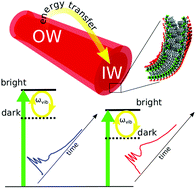Vibronic coherences in light harvesting nanotubes: unravelling the role of dark states†
Abstract
Self-assembled ordered structures, such as H- or J-type molecular aggregates of organic chromophores, are extremely interesting materials for different optoelectronic applications. In this work we present a novel characterization of light harvesting nanotubes formed by the self-assembly of amphiphilic cyanine dyes in water, through a combined ultrafast spectroscopic and theoretical approach. Under the condition of low inhomogeneous disorder at low temperature, broadband transient absorption spectroscopy revealed the presence of an unusual ultrafast behavior of the aggregate, manifested through intense and peculiar oscillations of the kinetic traces, lasting tens of picoseconds. Theoretical simulations were performed by adapting a model which grasps vibronically coherent effects in the double wall nanotube system experiencing inter-wall energy transfer. Good agreement between model predictions and experimental observations was obtained under the assumption of coupling between bright and dark electronic states. The model clarified the vibronic origin of the observed oscillations, evidencing new important pieces of information about transport mechanisms and excitonic interactions in these complex molecular systems.



 Please wait while we load your content...
Please wait while we load your content...